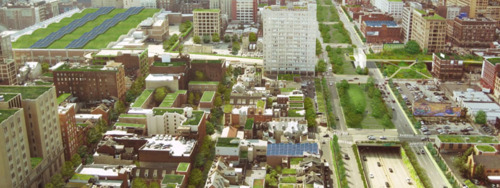
Open Source Cities
A global collection of the best ideas on the future of cities.
Search
Pages
Loading Tweet...
Links
Block by Block: Cities Tackle Big Problems With Small-Scale Solutions

By JESSIE FELLER, Regional Plan Association
The world’s biggest cities are discovering that it sometimes makes sense to go small.
Urban centers from New York to Sao Paulo to Singapore are grappling with big challenges, including climate change, population growth and fiscal constraints. Rather than addressing these issues solely with large, centralized strategies, some are turning to more diffuse approaches. So-called micro-solutions — which might mean relying on green infrastructure instead of a new water-treatment facility, or implementing car- and bicycle-sharing in place of a highway expansion — are generally much cheaper and faster to implement. They have the added benefit of reducing greenhouse-gas emissions.
One micro-scale innovation that has taken hold in places as diverse as Portland, Ore., Denver, Malmo, Sweden, and Brooklyn is the eco-district, a neighborhood or section of a city that attempts to use less energy and produce less waste of all kinds. The concept, which was devised by the Portland Sustainability Institute, emphasizes protecting the environment at the neighborhood level.
In eco-districts, property owners are encouraged to tap their joint purchasing and real estate power. In Washington, D.C., landowners have purchased solar panels to create local solar co-operatives. In New York, environmentalists are hoping to persuade clusters of buildings to band together to bring natural gas to their neighborhood, allowing them to replace polluting, hard-to-maintain boilers. Building owners lower their energy costs over the long term and decrease pollution in the process. One organization helping buildings and communities tap their joint purchasing and real estate power is Living City Block, which has active projects in Denver, Washington, D.C. and in the Gowanus Canal area in Brooklyn.
Elsewhere, cities that once would have launched large-scale projects to solve infrastructure problems are finding that some challenges can be meet with a smaller, greener footprint. Philadelphia, for example, has avoided building water storage and treatment facilities by implementing systems to catch rainwater and route it through soils and plants before it enters storm sewers. This means disconnected downspouts on homes (so gutters drain into the lawn), rain barrels to trap rainwater, vegetated swales, and porous pavement. Some of these solutions have the extra benefit of reducing the urban heat island effect and bringing more nature into the city.
Certain cities also are moving toward producing energy closer to where it is needed, through technologies such as solar, wind and co-generation plants. This approach, often called distributed energy generation, can be more efficient than having energy travel long distances on transmission wires. Nearly half the total electricity bill paid by utility customers in the tri-state region goes toward maintaining, replacing and expanding local facilities such as poles, wires, substations, and transfer facilities needed to reliably distribute power. Moreover, as much as 15% of the useful energy generated at a centralized power plant tens or hundreds of miles away can be lost when the energy travels to the ultimate electricity user. The key to successful distributed power is reliable infrastructure and battery storage technology, which is rapidly improving.
Another micro-solution that has caught on is car sharing. Just outside New York City, Hoboken’s new Corner Cars Program offers residents a car-sharing program with designated city parking spots. So far, the program has more than 1,000 members. New car-sharing models in Munich, Frankfurt, Boulder, Colo., and San Francisco now allow owners to rent out their own car for hourly segments and share it with other drivers. Innovations in group insurance plans have enabled these models to gain traction, and several companies have sprung up to facilitate the personal car rentals. Other programs allow users to pick up a car in one location and drop it off in another. All these models allow urban drivers to lower their vehicle-related costs, save time and avoid the hassle of looking for overnight parking.
While big infrastructure projects will always be necessary, for some problems, micro-solutions can do much of the work. Cities that are open to these ideas could emerge as the most resilient and able to adapt to energy constraints, climate change and demographic shifts. Most importantly, they will become more enticing places to live in, with less traffic, lower living costs and cleaner air and water.
Notes
 smartieflo88 liked this
smartieflo88 liked this newsfromtomorrow reblogged this from entrappedspaces
sustainableenergyz-blog reblogged this from opensourcecities
sustainableenergyz-blog liked this
chichichien-blog reblogged this from mengyi-fan
intervir liked this
clemauyeung-blog reblogged this from opensourcecities and added:
The power of forming communities for sustainable change. It looks like localized, decentralized decision-making is...
urbnfutr reblogged this from amritseera
mengyi-fan reblogged this from opensourcecities
davidtorregrosa-blog reblogged this from humanscalecities
shriyashriyashriya-blog liked this
machinami-blog reblogged this from opensourcecities
intervalos reblogged this from opensourcecities
senyorah-blog reblogged this from humanscalecities
entrappedspaces reblogged this from humanscalecities
caroline-christie-blog reblogged this from humanscalecities
wfplnews reblogged this from opensourcecities and added:
Read more
chrlib reblogged this from humanscalecities
 urbnist liked this
urbnist liked this postrationillest-blog liked this
elpliego-blog reblogged this from urbanistin
massurban liked this
 urbanistin reblogged this from opensourcecities
urbanistin reblogged this from opensourcecities buildbettercities-blog liked this
coffeeandblueprints liked this
j00by liked this
 moveslikejavertt reblogged this from humanscalecities
moveslikejavertt reblogged this from humanscalecities piecesofourpuzzles liked this
humanscalecities reblogged this from opensourcecities
 counti8 liked this
counti8 liked this Jessie Feller submitted this to opensourcecities
